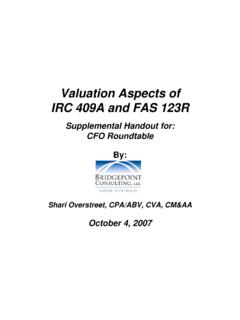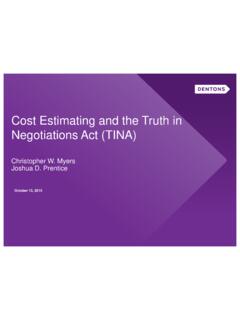Transcription of Procurement Process and the Sarbanes-Oxley Act May, 2005
1 Procurement Process and the Sarbanes-Oxley Act May, 2005 EXECUTIVE SUMMARY Public companies are spending a great deal of time and effort to comply with the Sarbanes-Oxley Act of 2002 (SOA). The measuring stick as to whether a company meets the standards of SOA is determined by the effectiveness of the design of and compliance to its internal processes. These internal processes include control activities used to ensure the reliability of the financial reporting and disclosure. Expenditures are a key element to managing financial risk, and spend management is an important ingredient to effective internal controls within the Procurement Process .
2 SiteStuff, Inc. (SiteStuff) is a Procurement company that offers web-enabled technology services for managing repetitive operating expenses for commercial Real Estate clients. Key service offerings include: bid management for building maintenance contracts, product ordering and order status, electronic invoicing and large project Procurement services . The SiteStuff service application suite provides a valuable Procurement solution for property managers and contains: Custom Request for proposal (RFP) templates and flexible bidding tools Extensive product catalog Comprehensive spend management reports Market validation reporting Consolidated and electronic invoicing The SiteStuff service application suite offers its clients the opportunity to efficiently implement or enhance their existing Procurement control environment.
3 David Powell of Texas, LLC (DPT) is an Austin, Texas-based consulting firm that provides internal audit services for SOA compliance to numerous publicly traded companies. DPT has identified typical control objectives, control activities, and risk of non-compliance around the internal controls of the Procurement Process . SiteStuff employed DPT to evaluate their Procurement service application suite to assess impact of SOA. This paper provides the results of the study with detailed identification of processes that align with SOA control activities. Our conclusion is that key features of the SiteStuff service application suite may enhance the Procurement Process and support compliance with Sarbanes-Oxley . SUMMARY AND KEY POINTS OF Sarbanes-Oxley The Sarbanes-Oxley Act (SOA) was passed by Congress in July 2002 in response to various issues, including corporate mismanagement and inaccuracies in public reporting.
4 The SOA requires public companies to demonstrate that they have effective internal processes surrounding financial controls, reporting and disclosure, in addition to addressing several other subject areas. The primary objective of the SOA is to protect investors by improving the accuracy and reliability of corporate disclosures made pursuant to the securities laws ( Sarbanes-Oxley Forum). One area of focus addresses the effectiveness of the design and operation of a company s internal controls. An example of an ineffective design may be the lack of documented policies and procedures, making it difficult to ensure the proper oversight and enforcement of the internal control. The operation of the internal control may be ineffective by virtue of the employees not consistently following formal procedures ( , obtaining approvals that are in the policy).
5 Clearly, key elements in a company s internal control structure are the controls surrounding its computer systems and computer applications that play a significant role in the accounting Process . SOA requires companies to assess these controls to ensure that they can be relied upon. Additionally, external auditors are now required to audit IT general computer controls and application-specific controls, certifying that they are functioning appropriately. Section 404 of the SOA requires publicly traded companies to disclose in their public filings with the Securities and Exchange Commission the effectiveness of their internal controls, as well as material weaknesses in their internal controls, if any exist. As a result, this legislation has created a major corporate effort to review and where necessary, implement policies and procedures relating to internal controls, test the effectiveness of these controls, and remediate any issues that are discovered.
6 Section 404 has resulted in the expenditure of significant internal resources as well as money for external consultants and auditors to comply with the necessary provisions. The CEO and CFO of public companies are now held accountable for the effectiveness of the internal controls of their company. Section 302 of SOA requires these executives to certify on a quarterly basis the accuracy of their financial reports and the adequacy of their internal controls. Additionally, Section 906 requires executives to certify that certain filings (including all quarterly and annual reports) comply with the disclosure requirements and accurately report the company s financial condition and operation results. As reported in the April 12th edition of Compliance Week, in March 2005, 116 companies disclosed material weaknesses within their internal controls.
7 Of these material weaknesses, seventy percent (70%) related to the financial close, account reconciliation, or inventory Process areas. Procurement REQUIREMENTS OF Sarbanes-Oxley The Committee of Sponsoring Organizations of the Treadway Commission (COSO) set forth a common framework for enterprise risk management. It is within this framework that internal control objectives and control activities are defined at a high level. These controls are then further defined and reviewed by external auditors of public companies. As you would expect, expenditures are a key risk area to the financial health of a company. A large part of expenses are controlled and managed through the Procurement Process . The control activities for these business processes are typically reviewed within the Procurement Process area and include the following sub- Process areas: Purchase Orders Receipt of Goods Invoicing Processing Payments Adjustments Some common controls over the Procurement Process are related to spending level approvals, proper recording of purchasing and invoice information, and segregation of duties among Procurement personnel.
8 Section 404 of SOA requires that control activities be tested by management and external auditors. The elements of Section 404 of the SOA focus on how well the internal controls of a public company are designed, documented, and then executed. The framework for internal controls is defined by control objectives, control activities, and risks. These are defined below. Control objectives: The internal processes that provide reasonable assurance of the effectiveness and efficiency of operations, reliability of financial reporting, and compliance with applicable laws and regulations. Control activities: The company-specific internal control processes that satisfy the control objectives and address the risks posed if the control objectives are not met. Risks: The negative consequences surrounding financial reporting and disclosure of not consistently adhering to the internal control activities.
9 Examples of typical control objectives, typical control activities and the risks associated within each of these business sub- Process areas are listed below. Procurement Function SOA Control Objective SOA Control Activity Risk of Non-compliance Purchase Orders PO transactions are reviewed and approved. Proper competitive bidding procedures are performed when required by the policy of the company or by federal requirements. Approved vendors are utilized. Procedures identify the parameters for selection of approved vendors to avoid the use of too many vendors for the same product or service. Purchasing of products and services occurs with improper oversight resulting in issues with spend management, unethical or non-existent bidding, or regulatory requirements. Goods Receipts Goods received are in the same quantity and quality as goods ordered through the All goods received are matched to an open purchase order and subsequent invoice and management reviews any exception.
10 Goods received do not match the quantity or quality of goods ordered. Goods received are improperly recorded or not recorded at all which can cause matching and tracking issues between PO s, invoices and receipt of goods. Invoicing Invoices appropriately reflect goods or services purchased and are accurately input for processing. Preconfigured customer options ensure vendors, quantities, price, extensions, footings, payment terms (including available discounts), supplier name and code, PO reference and accuracy of the account distribution are consistent between the invoice and PO. Inconsistent invoice processing can lead to paying incorrect amounts, overdue payments and unmatched documentation. Payments Disbursement is made to the correct payee and for authorized amounts. Items selected for payment are approved and payees name and address are automatically pulled from the customer approved vendor master file.

